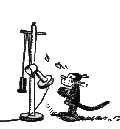twylaTharp Movie
(Quicktime mov)
.
.
.
The thing about research is that it opens so many wonderful and intriguing doors, yet at the same time accentuates how much I don't know and how much more I need to know. AND findout.
Yesterday I talked to ES, a dancer who utilizes improvisation in the process of her work, and infact often will perform an improvised piece. We talked about Butoh.
An interesting article which contains an informative background to the practice of Butoh and an outline of (a) Butoh method "
Butoh dance, a radical dance form originated by Tatsumi Hijikata in the 1950s in Japan, has been more than a performing art. "
Also we talked about the dancer and choreographer
Twyla Tharp

Tharp's methodology (at one point in her career). (I will have to qualify this information, as I have gleaned it from the conversation with ES. Also note that the Tharp movie that I popped into the title of this entry is edited and choreographed. I know not if it is improvised.)
Process:
1. Tharp improvises a dance and records it, (the performance or act).
2. She then gives the video to the dance company she is working with and instructs them to learn the dance.
3. Then as she watches the dancers perform she choreographs the piece.
The final product is a choreographed piece that has utilized improvisation within the process.
An example and comparison of production methods.
DANCE
1. Pre Production -improvise and record
2. Production -composit, into other bodies/performers
3. Post Production -choreograph/edit
ANIMATION
1. Pre Production -improvise and record
2. Production -composit
3. Post Production -edit/choreograph
Does it need to be edited? No. This is just a method that Twyla Tharp has used and I am comparing it to an animation production process. The recording of the improvisation is a noteworthy point in this comparison.
Other things to note and extrapolate upon at some point. (SOON!)
+++TIME.+++
+ The facility to record and playback an improvised piece. How this factors into improvisation techniques/outcomes in various media.
+ How various animation programmes incorporate this feature.
+ Improvisation is an unedited process, it is a creation realised (completed?) in the moment.
-Can it be edited?
-Yes.
-Is it still an improvisation?
-Yes. Improvisation is a technique that can be used in pre-production, production, and (even) post production.
-No. Though it has used the technique of improvisation within the production process to create the final piece.
+ The body. Acting and performing.
Animating a character is not just about making him/her/it smile and frown accordingly.
Essentially as an animator you are acting and performing through the medium of animation, the process of animating, which requires a certain set of skills and learned techniques. An example of one of these, in the case of my paper which focusses upon 2D animation, drafting skills . The "performing" character is a series of drawings, eg:12 to 25 drawings per second. Each drawing takes a certain amount of time to draft. Creation time outweighs performance time, which means the character can not be created and "perform" in realtime. IE: the animated character cannot perform live in the same way one can on stage with dance, theatre and music. So how can an animator improvise?*
+ Performing Improvisation = A state of mind, which also has to incorporate a state of mind/body.
In the case of animating, the actual crafting or creation of the medium requires the animator's expression of the mind/body to be realised through a series of sequential drawings through the physical act of hand eye coordinated movements.
The improvising animator has to combine a state of mind/body with the physical act of hand eye coordinated movements that essentially create a performance through sequential drawings of a character.
+Time+
To be improvising while animating one either needs to be drawing quite quickly (good drafting skills, cartoonist, abstract marks) to remain in "flow", or one needs to be able to create this sense of flow and remain focussed in a slower time frame (eg Kentridge).
Kentridge has his studio, technique and pre production set up in such a way so as to provide for this kind of focus and/or flow.
There is so much more to unravel and pick at in the previous parragraph. Infact alot of what I have written is quite problematic, and the definitions need to be grappled with and ironed out. but there it is for now.
+timing+
I watched Shrek 2 last night. I also interviewed DD from Playback Theatre Company.
We talked about timing. Which factors into the value of improvisation.
+ Voice actors improvising.
+ Improvising with other actors.
.
.
.
*Note: Already in this blog I have given a hypothetical technique to animate in realtime to music, using abstract marks. See blog entry: July 9 2004, Quick Sticks.














